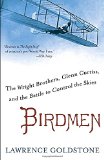Summary | Excerpt | Reviews | Beyond the Book | Readalikes | Genres & Themes | Author Bio
The Wright Brothers, Glenn Curtiss, and the Battle to Control the Skies

Critics' Opinion:
Readers' Opinion:
First Published:
May 2014, 448 pages
Paperback:
Apr 2015, 448 pages
 Book Reviewed by:
Book Reviewed by:
Poornima Apte
Buy This Book
Langley's interest in aviation predated his appointment by only months. As always, he eschewed theory and moved directly to experiment, building an enormous whirling-arm device on the grounds of the Allegheny Observatory and designing instruments to take measurements that would test conventional wisdom. His first notable success was demonstrating as false Newton's hypothesis that flight was impossible. (Newton, as did everyone before Cayley, had theorized using flat rather than cambered surfaces.) This allowed Langley to assert that motorized flight was indeed achievable with existing technology. From there, he set out to achieve it.
Bluff and thick-bodied, Langley was intimidating and imperious. He rarely performed the menial tasks of experimentation himself but instead employed a team of talented young assistants who were Highwa y in the S ky | 19 charged with adhering to minutely detailed instructions, some of which were contradictory or ludicrous. Langley demanded, for example, that the nuts and bolts of his models be polished as if they were museum pieces. He changed his mind repeatedly, causing much of his assistants' work to be scrapped before it was completed. Langley's overbearing manner created constant friction and would eventually cause a key defection from his team.
As expected, within months of his appointment as assistant secretary, Langley was named to the top post at the Smithsonian Institution. Although he didn't resign his post at the Allegheny Observatory until 1891, he moved to Washington, D.C., where, as an eminent newcomer, he found himself pleasantly in the center of the capital's social swirl. Among the many luminaries eager to talk science with the secretary of the Smithsonian was Alexander Graham Bell, who would become one of Langley's most ardent supporters and closest friends. Even with his notoriety, however, in a position so public, Langley needed to be circumspect about proclaiming his intentions to pursue an end that many still considered the province of the fanciful or the insane.
Proceeding cautiously, Langley set to work to build a powered, stable aircraft that could drive through the skies. He published his early findings in 1891 as Experiments in Aerodynamics, which at once illustrated his greatest strengths and most glaring weaknesses. While the data itself did seem to demonstrate that powered, heavier-than- air flight was feasible, his extrapolation of the data to a principle that asserted it took less power to fly fast than slow—which he called "Langley's Law"—proved to be embarrassingly incorrect.
Langley's objective was typically grandiose. He would leap past the aerodynamics—skip the unpowered glider phase—and proceed directly to powered flight. His prototype would be unmanned but if that could be made to work, a manned version seemed simply a matter of increasing the scale and power output of the motor.
Langley's assistants built a series of rubber models, none of which would successfully fly. Rather than analyze the principles under which the models were built, Langley decided that the problem was insufficient power and set to increasing the size of his models to accommodate a larger motor. Beginning in 1891, Langley's team built a series of what he called "aerodromes"; Langley, with no knowledge of Greek, was unaware that an aerodrome is a place rather than a thing. Langley's assistants tried different configurations, considered varying power sources, and attempted to utilize materials that would be both light and strong. Langley employed cambered wings but otherwise considered the aerodynamics of the craft subordinate to weight and power.
The first three aerodromes, numbers 0 through 2, were so obviously overweight and underpowered that Langley did not even attempt to test-fly them. The next two models were improved but still not capable of flight. But Langley's assistants, beleaguered constantly by their punctilious boss, were getting closer. Tandem sets of wings fore and aft of the motor set in a dihedral—in an upward slant from the body, forming a V—did well in simulations and, with a cruciform tail, provided the proper stability. A light steam engine could generate sufficient power per pound, and the spruce, pine, and silk construction reduced the weight of the craft to thirty pounds. To launch the aerodrome, the team settled on a catapult, which eventually evolved into a complicated overhead arrangement with tackle and pulleys. Langley purchased a flat-bottomed houseboat on which to mount the apparatus and eventually send an aerodrome ranging down the Potomac. All that was left was to get the most advanced aerodrome, number 6, to actually fly. To help find the solution to that final problem, Langley took on two new assistants.
Excerpted from Birdmen by Lawrence Goldstone. Copyright © 2014 by Lawrence Goldstone. Excerpted by permission of Ballantine Books. All rights reserved. No part of this excerpt may be reproduced or reprinted without permission in writing from the publisher.





The House on Biscayne Bay
by Chanel Cleeton
As death stalks a gothic mansion in Miami, the lives of two women intertwine as the past and present collide.

The Flower Sisters
by Michelle Collins Anderson
From the new Fannie Flagg of the Ozarks, a richly-woven story of family, forgiveness, and reinvention.

The Funeral Cryer by Wenyan Lu
Debut novelist Wenyan Lu brings us this witty yet profound story about one woman's midlife reawakening in contemporary rural China.
Your guide toexceptional books
BookBrowse seeks out and recommends the best in contemporary fiction and nonfiction—books that not only engage and entertain but also deepen our understanding of ourselves and the world around us.